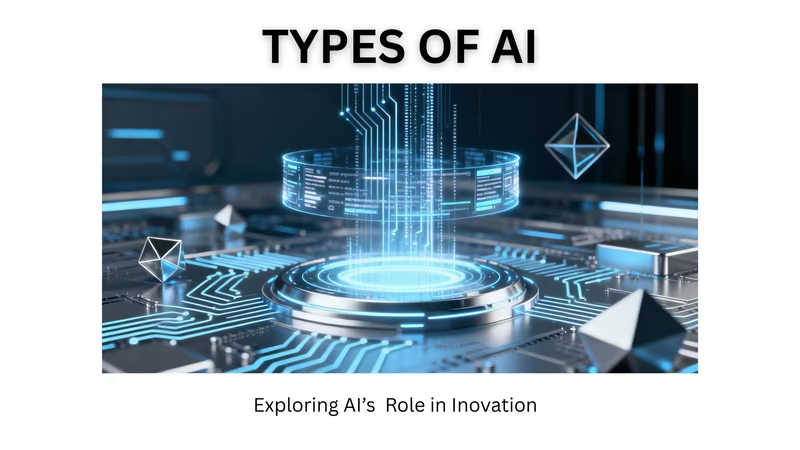Ever wonder how Netflix just knows what movie you want to watch next?
Or how Siri and Alexa seem to understand your commands (most of the time, anyway)?
That isn't really magic, it's AI. It sounds like something from a sci-fi movie, but let's be honest, AI is already all around us, working quietly in the background.
But what is AI, really? And are they all the same?
If you're curious about the different types of artificial intelligence and how they show up in your daily life, you're in the right place. Let’s actually break this down.
What Is Artificial Intelligence?
At its heart, artificial intelligence is really just about teaching computers to think, learn, and solve problems in ways that sort of mimic human intelligence.
We're not talking about creating robots with feelings. It’s about building systems that can look at a bunch of information, spot patterns, and then make a decision or a good guess.
Think of AI as the "brain" behind your smartphone’s smart suggestions.
When your phone suggests a faster route to work because it "knows" there's traffic, that's AI.
When your email finally filters out most of that junk, that's AI, too. It's basically a tool for handling tasks that until now needed a human.
Types of AI Based on Capabilities
So, one of the main ways people talk about the types of AI is by what they can do and their capabilities. This is that whole "weak vs. strong" thing you might have heard about.
1. Artificial Narrow Intelligence (ANI)
This is the only kind of AI we actually have right now. ANI (or "Weak AI") is a specialist. It’s designed and trained to do one specific thing. It operates in its own little box and can't do anything beyond what it was built for.
- Real-world AI Examples: Honestly, this is pretty much every AI you use. Your spam filter, Google Search, the facial recognition that unlocks your phone and even the computer-controlled opponents in a video game.
- They're all amazing at their one job, but you can't ask your spam filter to play chess. It would have no idea what you're talking about.
2. Artificial General Intelligence (AGI)
This is the next big step, the "strong AI" you see in movies. AGI is the idea of a machine that can understand, learn, and apply its smarts to solve any problem, just like a person.
It could learn to write a song, tackle a complex math problem, and then figure out how to bake a cake, all on its own.
- Real-world AI Examples: Just to be clear, this does not exist yet. It’s the big dream for a lot of researchers, and for now, it's pure science fiction. Think Data from Star Trek or the helpers in I, Robot.
3. Artificial Superintelligence(ASI)
This is the way-out-there, hypothetical stage. This is where an AI wouldn't just match human intelligence, it would completely blow past it.
An ASI would be smarter than all the most brilliant human minds combined, good at everything from creative thinking to problem-solving in ways we literally can't even wrap our heads around.
- Real-world AI Examples: This is purely theoretical, obviously. It's an exciting (and yeah, for some, a slightly scary) idea that drives a lot of debate about the long-term future of AI.
Meet the startups driving the AI revolution in 2025, and check the blog for more.
Types of AI Based on Functionality
Okay, so another way to slice this is by how the AI works. Like, how does it function, and can it "remember" things? This gives us four other categories.
1. Reactive Machines
This is the most basic type. Reactive machines can, well, react to what's happening right now, but they have zero memory of the past.
They see what's in front of them and make a decision based only on that.
- Real-world AI Examples: The classic example is IBM's Deep Blue, the computer that beat chess champ Garry Kasparov back in the 90s. Deep Blue didn't remember Kasparov's favourite moves or any other game; it just saw the pieces on the board right now and reacted.
2. Limited Memory
This is where most of the AI we use today lands. These AIs can look into the recent past to make a decision.
They build up a little "memory" from recent data, and that information helps them decide what to do next.
- Real-world AI Examples: This is your Netflix queue! It looks at what you just watched (its "limited memory") to suggest what's next. Self-driving cars are another huge one; they have to observe the speed and direction of other cars around them to decide if it's safe to change lanes.
3. Theory of Mind (In Development)
This is the next level researchers are trying to get to. This kind of AI would, in theory, be able to understand human thoughts, emotions, beliefs, and intentions.
It's about getting why someone is saying something, not just what they're saying.
- Real-world AI Examples: We are nowhere near this yet, really. We're just scratching the surface. Maybe one day, an advanced Siri could recognise the frustration in your voice and change its tone, but we're not there.
4. Self-Awareness (Hypothetical)
This is the final, and most futuristic, stage. We're talking about AIs that would have consciousness, self-awareness, and actual feelings just like us.
They wouldn't just be aware of the world but also aware of their own existence.
- Real-world AI Examples: Like the other big ones (AGI and ASI), this only exists in movies. It’s the ultimate, way-off-in-the-distance frontier of AI.
Emerging AI Technologies You Hear About
You’ve probably heard terms like "machine learning" and "generative AI" getting thrown around. These aren't types of AI in the same way we just discussed. They're more like the tools and techniques that make AI work.
Machine Learning (ML)
This is the engine that powers most Narrow AI. Instead of a developer writing a million rules, they "train" the ML system on tons of data.
It learns to find patterns all on its own. It’s like teaching a kid to recognize a dog by showing them thousands of pictures of dogs, not by trying to describe a dog.
Natural Language Processing (NLP)
This is the magic that lets AI understand and respond to human language (both spoken and written). It’s the tech inside Siri, Alexa, Google Translate, and those customer service chatbots.
Generative AI (GenAI)
This is the new kid on the block that everyone's talking about. Generative AI doesn't just analyze data; it creates new stuff.
This is ChatGPT (which writes text), Midjourney (which makes images), and all the other tools that can write code or even compose music.
Learn how AI and FinTech are reshaping digital lending.
Real-world Applications of Different AI Types
So, where do you actually see these AI types in daily life?
- In Your Pocket: Your phone's GPS (a limited memory AI) uses real-time data to find a better route.
- In Your Inbox: That spam filter (a narrow AI) is constantly learning to catch junk mail.
- On Your TV: Streaming services (Limited Memory AI) Learn your taste to recommend shows you'll actually want to watch.
- In Healthcare: AI (a specialized narrow AI) is getting scarily good at spotting problems in X-rays and MRIs, sometimes even better than a human doctor.
- In Banking: That fraud alert you get? That's a narrow AI monitoring your account for any transactions that seem "weird" for you.
The Future of Artificial Intelligence
Right now, we are planted firmly in the age of Narrow AI (ANI). The tools we use, from Siri to our spam filters, are specialists that mostly use limited memory.
They're helpful, and they're getting smarter every day.
All that "future of AI" talk you hear? That's about the push toward Artificial General Intelligence (AGI) and figuring out all the wild things Generative AI can do.
At the end of the day, the goal probably isn't to create a world run by robots.
It's about building tools that are smart enough to help us tackle humanity's biggest problems, from curing diseases and fighting climate change to personalising education and just making our lives a little easier.
It's Not Magic, It's Just Smart Tech.
So, the next time your phone's keyboard predicts your next word or Spotify creates a playlist that is spot on, you'll know what's going on.
It’s not some spooky ghost in the machine; it’s just one of the many types of artificial intelligence working to make our lives a tiny bit easier.
AI is one of the most powerful technologies we've ever built, and honestly, we're just getting started.
AI can’t buy gold (yet), but you can start buying digital gold on Jar today!










